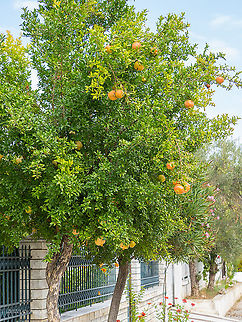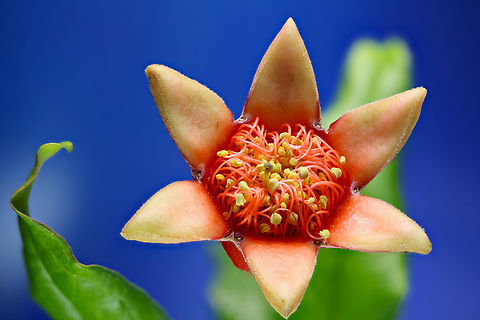
Appearance
A shrub or small tree growing 5 to 10 m high, the pomegranate has multiple spiny branches and is long-lived, with some specimens in France surviving for 200 years. "P. granatum" leaves are opposite or subopposite, glossy, narrow oblong, entire, 3–7 cm long and 2 cm broad. The flowers are bright red and 3 cm in diameter, with three to seven petals. Some fruitless varieties are grown for the flowers alone.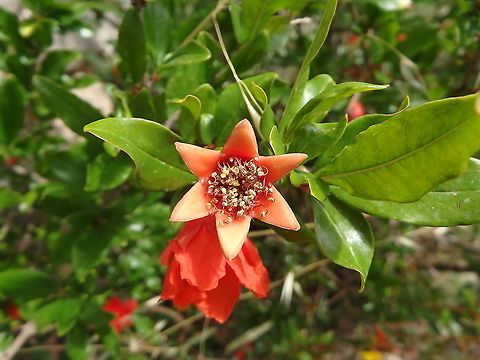
Naming
The name pomegranate derives from medieval Latin "apple" and "seeded". Possibly stemming from the old French word for the fruit,, the pomegranate was known in early English as "apple of Grenada"—a term which today survives only in heraldic blazons. This is a folk etymology, confusing the Latin "granatus" with the name of the Spanish city of Granada, which is derived from an unrelated Arabic word.Garnet derives from Old French by metathesis, from Medieval Latin as used in a different meaning "of a dark red color". This derivation may have originated from "pomum granatum", describing the color of pomegranate pulp, or from "granum", referring to "red dye, cochineal".
The modern French term for pomegranate,, has given its name to the military grenade.
Pomegranates were colloquially called 'wineapples' or 'wine-apples' in Ireland, although this term has fallen out of use. It still persists at the Moore Street open-air market, in central Dublin.
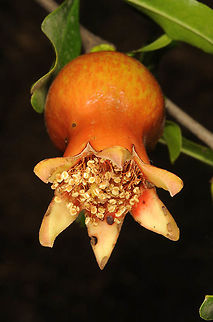
Distribution
The pomegranate was thought to have originated from Afghanistan and Iran before being introduced and exported to other parts of Asia, Africa, and Europe. It was introduced into Spanish America in the late 16th century and into California by Spanish settlers in 1769. They are widely cultivated throughout West Asia and Caucasus region, South Asia, Central Asia, north and tropical Africa, the drier parts of Southeast Asia, and the Mediterranean Basin. The fruit is typically in season in the Southern Hemisphere from March to May, and in the Northern Hemisphere from September to February.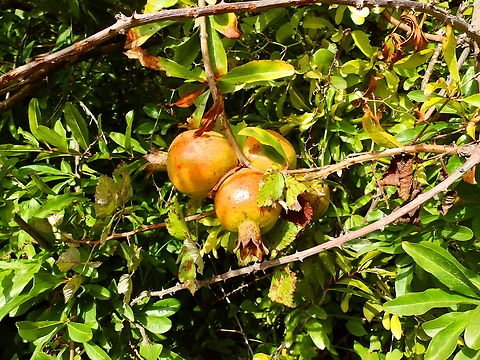
Evolution
The pomegranate is native to a region from modern-day Iran to northern India. Pomegranates have been cultivated throughout the Middle East, India, and Mediterranean region for several millennia, and it is also cultivated in the Central Valley of California and in Arizona. Pomegranates may have been domesticated as early as the fifth millennium BC, as they were one of the first fruit trees to be domesticated in the eastern Mediterranean region.Carbonized exocarp of the fruit has been identified in early Bronze Age levels of Tell es-Sultan in the West Bank, as well as late Bronze Age levels of Hala Sultan Tekke on Cyprus and Tiryns. A large, dry pomegranate was found in the tomb of Djehuty, the butler of Queen Hatshepsut in Egypt; Mesopotamian records written in cuneiform mention pomegranates from the mid-third millennium BC onwards.
Waterlogged pomegranate remains have been identified at the circa 14th century BC Uluburun shipwreck off the coast of Turkey. Other goods on the ship include perfume, ivory and gold jewelry, suggesting that pomegranates at this time may have been considered a luxury good. Other archaeological finds of pomegranate remains from the Late Bronze Age have been found primarily in elite residences, supporting this inference.
It is also extensively grown in southern China and in Southeast Asia, whether originally spread along the route of the Silk Road or brought by sea traders. Kandahar is famous in Afghanistan for its high-quality pomegranates.
Although not native to Korea or Japan, the pomegranate is widely grown there and many cultivars have been developed. It is widely used for bonsai because of its flowers and for the unusual twisted bark the older specimens can attain. The term "balaustine" is also used for a pomegranate-red color.
Spanish colonists later introduced the fruit to the Caribbean and America, but in the English colonies, it was less at home: "Don't use the pomegranate inhospitably, a stranger that has come so far to pay his respects to thee," the English Quaker Peter Collinson wrote to the botanizing John Bartram in Philadelphia, 1762. "Plant it against the side of thy house, nail it close to the wall. In this manner it thrives wonderfully with us, and flowers beautifully, and bears fruit this hot year. I have twenty-four on one tree... Doctor Fothergill says, of all trees this is most salutiferous to mankind."
The pomegranate had been introduced as an exotic to England the previous century, by John Tradescant the Elder, but the disappointment that it did not set fruit there led to its repeated introduction to the American colonies, even New England. It succeeded in the South: Bartram received a barrel of pomegranates and oranges from a correspondent in Charleston, South Carolina, 1764. John Bartram partook of "delitious" pomegranates with Noble Jones at Wormsloe Plantation, near Savannah, Georgia, in September 1765. Thomas Jefferson planted pomegranates at Monticello in 1771; he had them from George Wythe of Williamsburg.
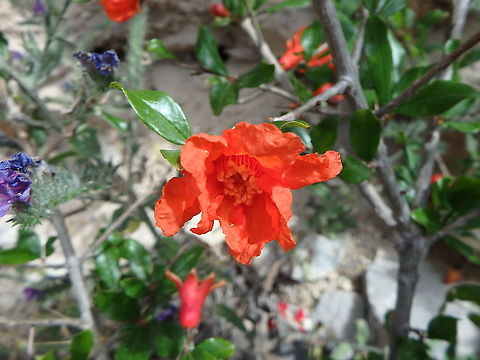
Cultural
Pomegranate is an important fruit and symbol in Kurdish culture. It is accepted as a symbol of abundance and a sacred fruit of ancient Kurdish religions. Pomegranate is used as a symbol of abundance in Kurdish carpets.The Pomegranate Festival is an annual cultural and artistic festival held to exhibit and sell pomegranates, food products, and handicrafts.
References:
Some text fragments are auto parsed from Wikipedia.
